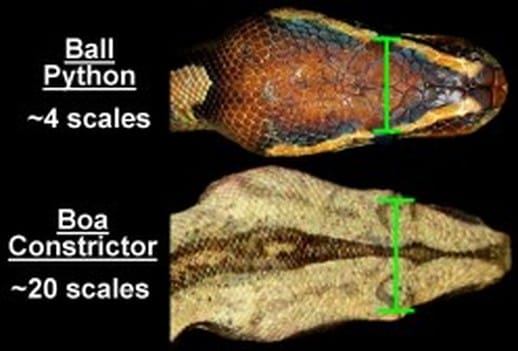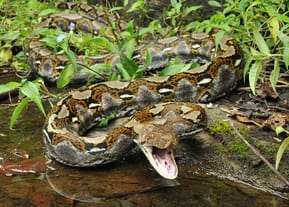Boa vs Python differences |

Custom Search
|
So how can we tell Boas and Pythons apart?Habitat / Range
Most boa species live in the western hemisphere, in central and South America like the boa constrictor, emerald tree boa, or the Brazilian rainbow boa. But a few species live in Africa and islands such as Madagascar, Fiji and Reunion Island. Pythons are exclusively Old World snakes, found in Africa like the ball python, Australia like the carpet python and olive python, and Asia. But they were accidently introduced to North America, and since the 1980's the Burmese python, African rock python and the reticulated python are considered an invasive species in the Florida Everglades. Anatomy The bones found in the head of boas are distinct from other snake species like pythons since they have fewer bones. Boas also have fewer teeth when compared to pythons. In pythons, we find a pair of upper jaw bones called the “premaxilla” that also have teeth. They both have tiny vestigial limbs a remainder of their legged ancestors, that can be seen today as small "spurs" near their tail. Both snake species also have 2 lungs, although most snake species have only 1 lung. Most python species heat-sensing pits along the lips, these specialized organs enable them to detect tiny differences in temperature, allowing these snakes to hunt down warm-blooded prey, such as mammals and birds. Reproduction
Most species of boas are ovoviviparous snakes meaning they are born as live hatchlings from eggs incubated inside their mother. The pythons are oviparous snakes, meaning they lay eggs. The female after laying the eggs, incubates them to keep them warm. Size Boas on average are smaller than pythons. Most large boa species measure anywhere from 4 to 12 feet (1.2 to 3.7 m) depending on the species and gender, the only "giant snake" in the boa group is the green anaconda capable of reaching more than 20 ft in length. Whereas pythons have several "giant" species reaching more than 20 feet (6 meters) in extreme cases. These giants include the invasive species mentioned before, the Burmese python, the African rock python and the reticulated python. When it comes to size both snakes have been considered the biggest snake in the world, depending on how they are categorized. The green anaconda grows to be the heaviest snake whereas the reticulated python grows to be the longest snake in the world. But even these giants are dwarfed by the extinct Titanoboa (Titanoboa cerrejonensis), which measured a whopping 42 feet (13 meters) and weighed about 2,500 lb (1,135 kg ).
|
Did You Know?
The african gaboon viper has the longest fangs of any venomous snake measuring up to 2 inches (5 cm). |
© 2014 Snake Facts About Us | Privacy Policy | Contact









